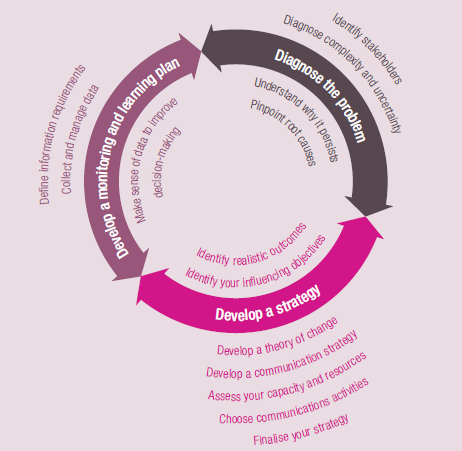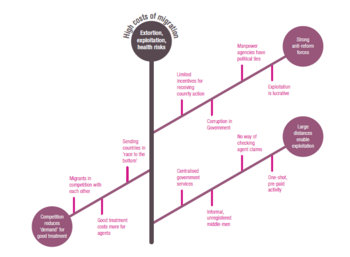RAPID Outcome Mapping Approach (ROMA)
Contents |
Introduction
Project managers find many complications when handling complex projects in which the environment within policies are made are also tangled. To just roll out a plan and measure predefined indicators could not be enough. ROMA, born from these situations, is an approach to develop policy engagement processes to influence change. It comprises a suite of tools that can be used to improve how organizations and companies diagnose the problem, understand the types of impact their work could have on policy-making, set realistic objectives for policy influence, develop a plan to achieve those objectives, monitor and learn from the progress they are making and reflect this learning back into their work. In other words, it will help to unpack complex problems, analyze stakeholder influence and understand pathways of impact in conditions of uncertainty.
Policy processes can be highly political and can involve complicated networks of actors with different values and interests. These types of environment require a collaborative approach, and ROMA has been designed specifically to facilitate collaborative engagement.
Concepts
Policy
Set of decisions that give rise to specific proposals for action. These decisions can vary from legislation to setting standards, allocating resources between organizations, changing the levels of subsidies or taxes...
Outcome Mapping
It is an approach to planning, monitoring, and evaluation that puts people at the center, defines outcomes as changes in behavior and helps measure contribution to complex change processes. It is based on a series of small and incremental steps and states that sustainable change comes from people's behavior. [2]
[2] https://www.outcomemapping.ca/
Background
RAPID
The RAPID (Research and Policy in Development) team is part of the Overseas Development Institute(ODI). Its main focus is to achieve a deeper understanding of the links between projects (mainly research) and policy.
ODI
ODI is an independent think tank on international development and humanitarian issues. Its puerpose is "to inspire and inform policy and practice which lead to the reduction of poverty, the alleviation of suffering and the achievement of sustainable livelihoods in developing countries." [1]
[1] https://www.odi.org/about-odi
Method
This method is designed to be done as a group exercise in which more diversity in the team will outcome as a more detailed analysis. It is an analysis and workshop-based technique that encourages feedback from teams working on diverse issues and in very distinct contexts. It is also scalable, meaning that it can be applied to a small intervention, such as the promotion of research findings during an event, or to a large multi-year program or campaign to try to influence in a particular sector. As research-based evidence is used in this method, it cannot only rely on the quality of the evidence but also on other major factors.
These factors are the Context, Evidence and Links (CEL) framework: The political context – political and economic structures and processes, culture, institutional pressures, incremental vs radical change etc. The evidence – credibility, the degree it challenges received wisdom, research approaches and methodology, simplicity of message, how it is packaged etc The links between policy and research communities – networks, relationships, power, competing discourses, trust, knowledge etc.
ROMA consists of three main activities, each of which is broken down into a series of steps:
Diagnose the problem
Usually, the pressure of the deadline to define the root cause lead to symptoms. To avoid this situation ROMA propose two techniques:
Five Why Basically, consists of asking several times why to the cause found. This will allow the team to reach a deep understanding of the issue.
Fishbone Diagram After the Five Why technique, the main cause can be broken down into different ones.

